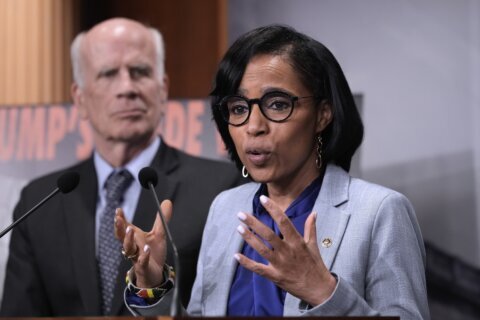This article was republished with permission from WTOP’s news partners at Maryland Matters. Sign up for Maryland Matters’ free email subscription today.
A new summer nutrition program that one advocate called a “game-changer” reached 586,734 children this summer, 43,000 more than state officials had expected, according to recent numbers from the Maryland Department of Human Services.
But officials said there is still time to sign up for the program, and were encouraging families to do so before the Aug. 31 deadline, in order to get $120 per child for grocery assistance.
“Marylanders want to help fight childhood hunger,” Maryland Human Services Secretary Rafael J. Lopez said in a written statement. “Our Maryland SUN Bucks program represents the single largest investment Maryland has seen to help feed our children. We invite every eligible Maryland family to apply before August 31, 2024, to help families buy groceries this summer.”
Because Aug. 31 falls on a Saturday, the department said families will only have until 5 p.m. Friday, Aug. 30, to submit their applications.
The federally funded program is aimed at closing the so-called summer hunger gap, when schools that provide free or low-cost meals to many children are closed. Under the Sun Bucks program, low-income and foster families can get $120 per child to help pay for the cost of groceries over the summer.
Ayesha Holmes, director of No Kid Hungry Maryland, says Sun Bucks has been a “game changer” for families in the state, and she wants to make sure all eligible families have an opportunity to get the Sun Bucks financial support before time runs out at the end of the month.
“Families are more hungry during the summer than the school year, because children have access to school meals and during the summer those meals are not available,” Holmes said. “So, this is an opportunity to make up that grocery budget, in a way that does not put so much strain on them.”
Just under 56% of the 893,241 student in Maryland public schools were on a free or reduced-price lunch program during the 2023-24 school year, according to data from the Maryland State Department of Education.
The issue of a summer hunger gap is not unique to Maryland.
The SUN Bucks program, also referred as the Summer Electronic Benefit Transfer Program, is one tool states can use to bridge the gap.
Maryland is one of 37 states and the District of Columbia that opted into the new program for summer 2024, along with five territories and the Cherokee and Chickasaw tribes. The program is run by the Department of Agriculture’s Food and Nutrition Service.
Holmes said that the Sun Bucks, in conjunction with other state programs and nonprofit efforts to feed kids over the summer, “really helps to close that gap in the summer time.”
When Sun Bucks launched in June, Maryland officials anticipated the program would distribute about $60 million in federal funds to help 543,000 kids across the state. But as of this month, a little more than $71 million had been handed out to 586,734 children in the state, according to Department of Human Services, with the possibility of more families being added.
“Our original estimates were based on federal data. We are delighted that we are serving 586,734 children,” according to a statement from the department.
“We requested and were approved by the federal government for a total estimated direct federal benefits to families of $71.04 million. This increased federal investment comes at no additional cost to Maryland,” the statement said. “At the end of the summer, we will have final numbers.”
The program has cost the state about $5.8 million to implement, according to the department, but all the benefits payments come directly from the federal government.
About 90% of eligible Maryland families were automatically enrolled in Sun Bucks because they were already in other benefits programs, like Supplemental Nutrition Assistance Program (SNAP), free or reduced-priced school meal programs, or temporary cash assistance. For families already on SNAP, the summer grocery funds are loaded onto their electronic benefits cards for that program.
“What we want to make sure is that, they’re able to get to the grocery store and stretch their own dollar,” Holmes said. “And it provides families directly on a debit card that they can use at the grocery store, or even farmers markets and local markets that accept them.”
Families who are not enrolled in those program can still apply for Sun Bucks if they meet the income qualifications at the Department of Human Services website.
“So it’s totally worth it, and even if people miss the deadline for this year, they’re just enrolled for next year. So go ahead and get it done,” Holmes said.







